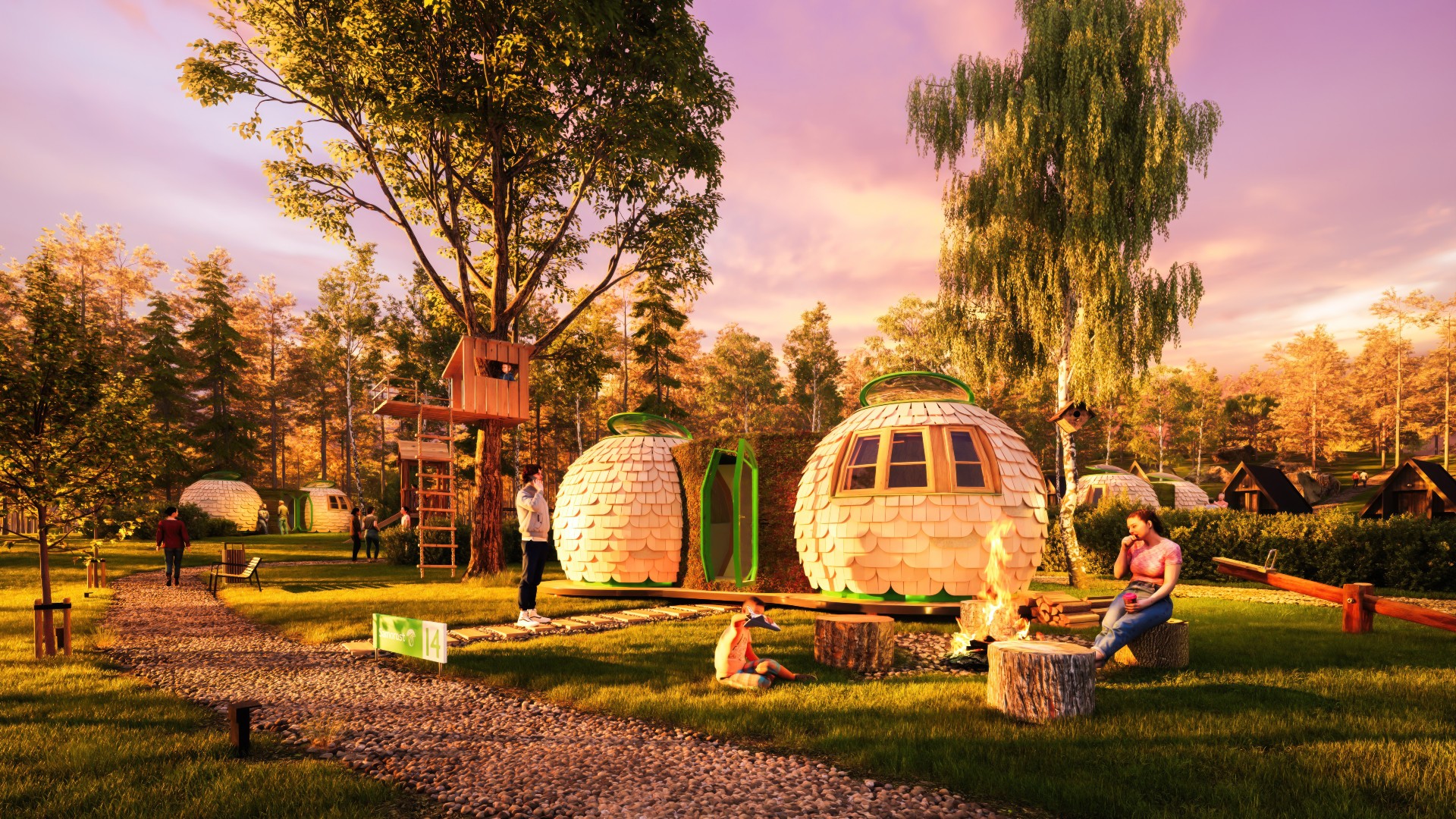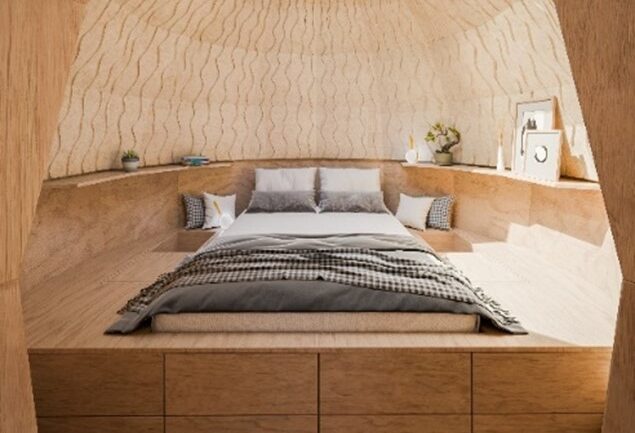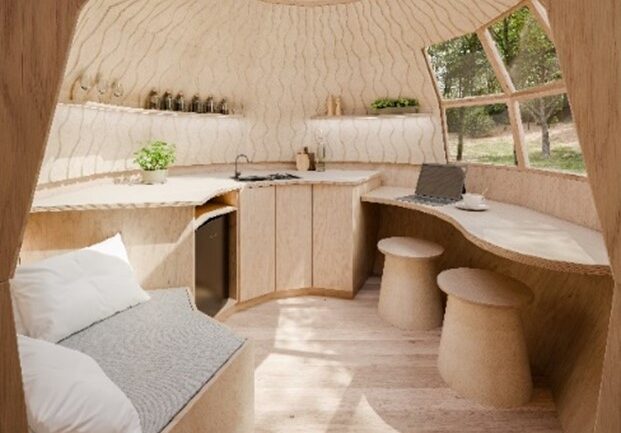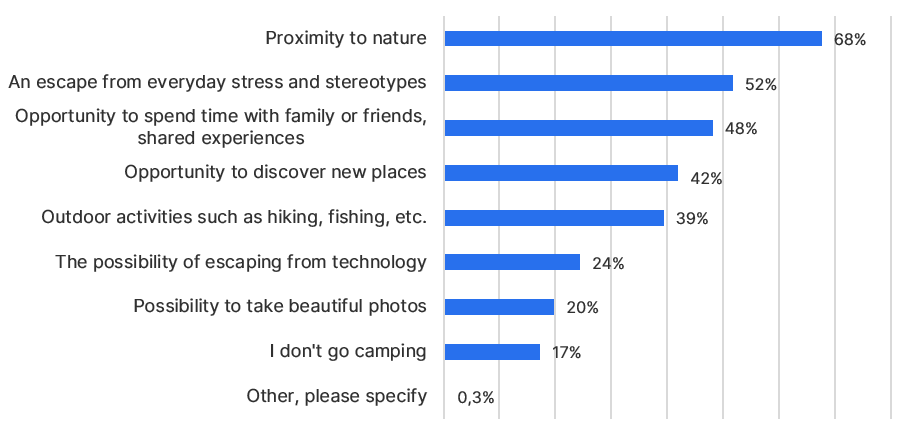Glamping on the rise: environment among campers’ priorities
The word ‘glamping’ first appeared in the UK in 2005, and in 2016 it was added to the Oxford English Dictionary. Since then, glamping (a portmanteau word that combines ‘glamourous’ and ‘camping’) has gained many fans not only in the UK, but also globally. And this phenomenon is gradually starting to conquer the Czech Republic as well. A survey on camping conducted by CS Building Savings Bank Burinka (member of Erste Group) as part of the SAMOROST project, confirmed that 43% of Czechs would like to try glamping. One in ten respondents prefer places that are environmentally friendly. The SAMOROST house will revolutionise modern camping (and sustainable construction in general). It will be the first house in the country to use a natural building material based on mycelium, especially in the form of insulation and interior cladding. It will thus offer visitors a combination of nature and comfort.

The future of nature-friendly tourism
Glamping is becoming more and more popular not only in the Czech Republic but also around the world. This is evidenced by FMI market analysis, according to which the glamping market will reach a value of USD 12.4 billion in 2024 and will exceed USD 39.9 billion by 2034. One of the main reasons for the growth of this market is its popularity among eco-minded travellers. With the growing emphasis on eco-friendliness, one third of travellers are choosing sustainable camping options, as evidenced by CS Building Savings Bank Burinka’s survey of Czechs. “We were pleasantly surprised how many people are taking an environmentally responsible approach to camping. When deciding where to go camping, the environment is a crucial factor for more than a third of respondents. One in ten of those surveyed exclusively seek out camping sites that are environmentally friendly,” says Monika Kopřivová, the company’s external communications manager.
People are looking to reduce their environmental footprint and so prefer to be environmentally friendly and sustainable as much as possible. Social media also plays a vital role, allowing campers to share stunning photos and unique experiences, thus increasing the appeal of glamping.
Proximity to nature versus overcast weather… and the occasional deluge
“In general, it’s clear that the behaviour of Czech tourists has changed in several ways over the last decade. Stays where people are closer to nature are in vogue. In this context, there’s also been growing interest in somewhat alternative holidays – such as glamping, which combines the comfort of a hotel with the adventure and romance of a campsite. It’s popular across the generations and represents a way of camping that offers more privacy. Offers are often geared towards romance, which couples go for and sometimes families, too (an example being treehouses, which are much appreciated by children). Lastly, glamping is an attractive way to travel sustainably while also allowing people to take advantage of modern conveniences. It certainly offers a much closer connection to nature than, for example, staying in a hotel,” summarises František Reismüller, Director of the Czech Tourism Centre, adding: “We post a number of glamping tips on the portal Kudy z boredy, where glampers can find 100 tips for luxury camping in the countryside. And through our special section on the VisitCzechia website, we showcase glamping opportunities to visitors from abroad.”
 |
 |
According to FMI’s market analysis, the kings of glamping are France, with more than 8,000 luxury campsites, followed by the USA, UK, Canada, Spain, Japan, Germany, China, and Australia. In the Czech Republic, glamping experienced a boom in 2020 during the outbreak of the Covid-19 pandemic, when people started building their own properties away from the crowds but still looked to incorporate creature comforts. There are currently about 600 campsites here in the Czech Republic, offering a variety of accommodation options from tents and caravans to cabins and bungalows. The CS Building Savings Bank Burinka asked what people like about camping.
What do you like about camping?

Source: CS Building Savings Bank Burinka (member of Erste Group) (data collection was carried out via Instant Research by Ipsos, April 2024, 1,050 respondents)
FMI’s market analysis reveals that rising numbers of people want conveniences such as beds, Wi-Fi, and modern technology that allows mobile check-in and a personalised service. Remote working became all the rage during the Covid-19 pandemic, and the opportunity to work in the wild is attracting those who can take advantage of this opportunity.
According to the CS Building Savings Bank Burinka survey, the biggest disadvantages of camping are the unpredictable weather (39%), lack of comfort (33%), and limited conditions for hygiene (33%). About a quarter of respondents (27%) are afraid of thieves and 18% of wild animals. Other disadvantages mentioned were old facilities (13%) and insufficient privacy (10%).
A SAMOROST House turns the disadvantages of traditional camping into advantages
Currently, there is a building being built in the Czech Republic that could revolutionise the modern way of camping – and not only here. The SAMOROST House will either erase all the drawbacks of camping or turn them into positives.
“The SAMOROST House will be the culmination of the eponymous project to research and develop mycelium-based materials for use in sustainable construction. Our house will demonstrate the ways in which this purely natural material can be used. It could replace, for example, polystyrene. At this stage, we are working with one version of a residential house – a pod for glamping and eco-friendly camping. Inside this new dwelling not only won’t you mind ugly weather, you’ll actually enjoy it thanks to the skylight. The house is designed so that you’ll be safe from unwelcome guests while enjoying camping in comfort and luxury, including access to basic hygiene requirements,” says Jakub Seifert from the association MYMO, which, , together with CS Building Savings Bank Burinka, is behind both the project and the SAMOROST House. “There will be many more ways to use the mycelium house in practice. A pilot version will be ready at the end of this year.”
About SAMOROST
Launched in April 2023, SAMOROST is a pioneering step towards sustainable construction and housing. Behind this ambitious project, CS Building Savings Bank Burinka and experts from MYMO have teamed up to explore the possibilities of using mycelium-based materials in construction.
The year 2023 was a period of intensive research and design. Experts were focusing on mycocomposite, and, by carrying out a series of tests, discovered that this natural material has the potential to replace non-organic materials commonly used in construction, like polystyrene.
Proof that the material is not only functional, but also beautiful and usable in modern design was demonstrated by an experiential exhibition at the international Designblok festival. The SAMOROST team presented furniture and interior accessories made from mycocomposite.
In 2024, the project moved to the next phase: production of the SAMOROST House began. This house will be an example of how mycelium can be used in sustainable construction. The house will be completed by the end of the year and will be presented to the public in 2025. The project has also received official recognition from the Minister of the Environment, Petr Hladík.
More information
Who are MYMO
MYMO brings together researchers who have set themselves the goal of laying the foundations for mycelial architecture in the Czech Republic. These are experts from the Department of Architectural Modelling at the Faculty of Architecture of the Czech Technical University (MOLAB) and experts from the company Mykilio. To this end, Kateřina Sýsová, Karolína Petřeková, Petra Jašicová, Jiří Vele, Matěj Róth, Jakub Seifert and Tomasz Kloza are researching and developing a material based on mycelium found in mushrooms. At the same time, together with CS Building Savings Bank Burinka, they want to raise awareness of the potential of mycelium in construction among professionals and the wider public.
About building savings bank Burinka (meber of Erste group)
For 30 years we have been providing clients with advantageous building society services, including comprehensive financial advice. We currently focus on financing energy-sustainable renovations and offering related subsidy advice. Our profile as a reconstruction bank is reflected not only in our product and service offering, but also in our communications. We have prepared a 10-part series on Sustainable Reconstruction with Buřinka. The combination of expert articles and light-hearted videos aims to convince anyone who is still hesitant about cost-saving reconstruction. We also share low-cost tips on how to save money in individual rooms here.
As a building society, we also feel a commitment to the construction industry, which we fulfil by supporting innovative processes and materials used in house building. To learn more about our projects in support of science and research in the construction industry, visit www.inovaceodburinky.cz/en.
Contact for media
Monika Kopřivová
External Communications Manager of building savings bank Burinka (meber of Erste group)
E-mail: monika.koprivova@burinka.cz
Mobile: +420 724 097 666
